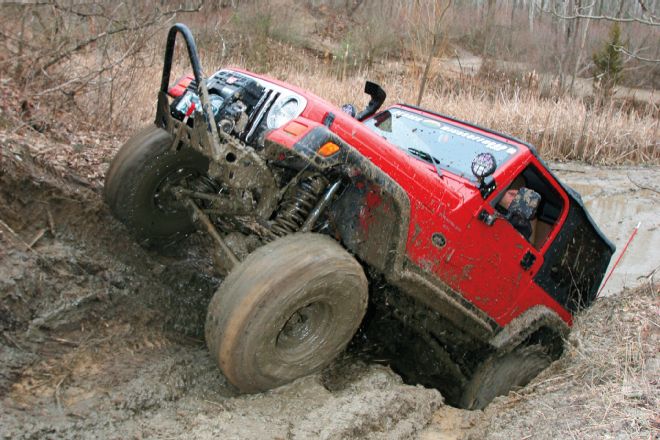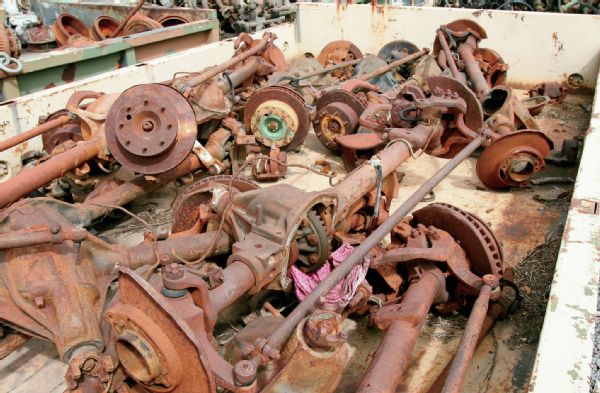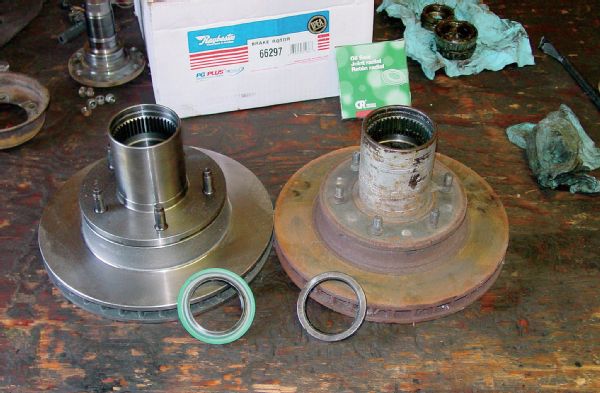
 John Cappa
Former Editor, Four Wheeler
John Cappa
Former Editor, Four Wheeler
Q: I’d like to get rid of the stock cat-back exhaust on my ’00 4.0L Jeep Wrangler TJ. I want something really loud, but livable, because it is still my daily driver. I’m on a budget (not spending more than $150) and my intention is to buy either a Dynomax Bullet, Flowmaster Super44, or other muffler. I plan to fab up an exhaust flange, weld it to the muffler, fab a turndown, weld it to the muffler, and then mount everything without cutting the old stock exhaust. This way I can put it back to stock whenever I want. What muffler do you suggest? I will retain the stock exhaust system from the headers to the converter. I know I’ll never have a V-8 sound because simply the inline-six is not a V-8; however, I really want to be noticed for the roar.
Dario Sguinzi
Via facebook.com/JohnCappa4x4
A: Picking a favorite muffler is like picking a favorite ice cream. Everyone has an opinion of what sounds good. Also, what muffler sounds great on a V-8, may sound terrible on an inline-six or four-cylinder. For whatever unfortunate reason, the V-8 engines in most of my projects have been pathetic. Stock mufflers make them sound even worse. I’ve had really good luck with Flowmaster 40-series mufflers (flowmastermufflers.com). They make my crappy engines sound high-performance, and they make high-performance engines sound awesome. An inline-six is a slightly different animal though. I recommend that you go to the Four Wheeler website here, http://bit.ly/1nIoDgU, to check out a story specifically about the sound each aftermarket muffler makes on a 4.0L Wrangler. You can find the video sound bites online too.
Q: I’m looking to upgrade the old headlights in my 4x4. They are 7-inch sealed-beam lights. What is a good inexpensive option?
Robby Jenkins
Encinitas, CA
A: Sealed-beam headlights are often only slightly better than putting a couple candles on your front bumper, especially when driving off-road. A little known fact is that sealed-beam lights become less bright the older they get. So, even though your old headlights still light up, they could be dimmer than the neighbor kid down the street that eats paste. The good news is there are plenty of headlight upgrades available for older 4x4s that fit even the biggest budget. Several companies offer halogen replacements, LED up-fits, projection lights, and even HIDs. If you are looking for a quick and inexpensive bolt-in upgrade that won’t require any additional wiring, consider Sylvania SilverStar (sylvania.com) sealed-beam lights. The lights are available for all of the common older applications that suffer from poor lighting. At $15 to $20 each, they are a bargain for the lighting performance they provide.
Q: I need help swapping from a Dana 44 to a Dana 60 in the front of my 1973 fullsize. What am I going to have to do to make it right? It has a four-speed and an NP205 with a dropped transfer-case mount.
Tom Black
Via fourwheeler.com
A: I’ll go ahead and assume you are working on a 1973 GM truck. If that’s the case, the swap from a Dana 44 or 10-bolt front axle to a GM Dana 60 is pretty much a bolt-in swap for all 1973 to 1987 pickups (to 1991 for Suburban and Blazer). You’ll need to locate the correct 1-ton spring plates and a U-bolt kit to complete the installation. Your shocks and steering should bolt right up, but you may need to change the brake lines. You may be able to get by with your stock driveshaft if your truck has a slight lift.

If the truck is factory height, your driveshaft might be too long for the larger front center section of the Dana 60. However, even if your driveshaft does fit, make sure that it won’t over compress when the suspension cycles. If the driveshaft completely collapses over a big bump, the jackhammering effect could eventually snap your transfer case in half. Also, make sure the Dana 60 gear ratio matches whatever axle you put in the rear.
Q: I have owned three Grand Cherokees, and last year, I bought a 1998 TJ primarily for off-road/mud-plugging. Rock crawling does not exist here in the UK. The TJ was modified for off-road work when I bought it. It has a 6-inch Rough Country lift with some Rubicon Express parts. It has a winch, snorkel, 35-inch tires, and a transfer case and drivetrain that have all been modified for the lift. I added a set of Bilstein 5100 shocks.
The previous owner had changed out the Dana 44 rear axle (standard fitting on all UK TJs) for a Dana 35 with disc brakes and a Detroit locker (yes, I know what you are thinking). The TJ is running 3.73 front and rear gears, and the front axle is out of a 1999 XJ Cherokee.
I recently broke two teeth off of the ring gear in the rear diff when driving off-road and did not know it. I kept hearing a slight clunk, but other than that, the TJ was working well. There was some very thick mud on the trail and I was sure I heard the locker kicking in when I was belly deep and started to think I would not get through.
I change the fluids every four-wheeling (off-road) sessions just because of the mud and water. When I opened the rear diff, the two teeth were in the oil that came out.
To cut to the point, I am replacing the rear axle with a used Dana 44. This axle also has 3.73 gears. What I would like your advice on is this: Is the 3.73:1 gear ratio good for what I do with the TJ? It is only used on-road to drive to and from off-road sites. It is not a daily driver. If I go a long distance with the Jeep, I put it on a trailer so I can always get home if anything breaks. My wheeling consists of many terrains, plenty of mud, climbs, descents, and so on. Fuel consumption and highway performance are not important to me. I have read too many articles about what is best online but I respect that you don’t mess about and say it like it is. If you have the time I would love to get your opinion on the best gear ratio for my TJ. I have a spare set of 32-inch mud tires and was even thinking of using them to see what a difference they would make.
Mike Worrall
Scotland, UKS
Editor Hazel replies:
A: Greetings, Michael! I love hearing from enthusiasts outside the U.S. Thanks for writing.
For starters, allow me to clear up one common misconception about a Detroit Locker. They engage (lock) under power and stay locked as long as power is being applied. They only disengage when no power is being applied and there’s a torque bias to overcome the springs inside the unit. By torque bias, in this case, I mean one tire travelling faster than the other. So in other words, the locker shouldn’t disengage unless you’re off the throttle and the vehicle is turning while moving. It doesn’t have to be a big turn – just enough to make one tire spin faster than the other. However, the key is it will only disengage when you’re off the throttle, not while you’re on the power.
All that understood, when you say you were “hearing the locker kicking in while you were belly deep in mud,” it’s doubtful the noise you heard was the locker engaging and disengaging. More likely what you were hearing was the teeth that broke off your ring gear rattling around inside the axle. Since you’re swapping to a Dana 44, it’s really a moot point, but I just figured I’d take the opportunity to address that.
As for the gear ratios, I know you said mileage and on-road drivability aren’t your primary concern. Still, my recommendation would really come down to whether your Jeep has the three-speed automatic transmission used in 1998 or the five-speed manual (AX15) with Overdrive. Ideally, for a 4.0L-powered Wrangler running 35s, I’d recommend 4.56 gears for the best off-road performance. For myself, I’ve run gearing as deep as 4.88 on a daily driven 4.0L/four-speed auto with Overdrive-equipped Cherokee with 33s. The road speed doesn’t suffer as long as you have the Overdrive, and the 4.0L will happily spin near 3,000 rpm above 75 mph on the highway all day long. So your engine speed would be around 3,100 rpm at 65 mph. If that’s acceptable, then the 4.56s may be for you.
In a nutshell, I’d recommend 4.56s, but keep in mind it’ll be rather expensive to regear both the front and rear axles. It’s not just the parts, but the labor involved. Find a good shop in your area that’s well-versed in setting up gears. You don’t want to destroy a brand-new gearset because of an improper installation. You’ll be able to reuse your front carrier on the high-pinion Dana 30, so that saves you a little money. On the rear, if the axle you’re starting with already has 3.73-numerically lower gears, then you’ll need a new carrier for 3.92-up gears. This probably isn’t an issue considering you’ll want to put another locker in the rear. If you can afford it, I’ve had really good luck with the Eaton Elockers, but if you’re a Detroit fan, go for what you like. You could also consider a full spool for the rear. They act like a Detroit Locker but without all the drawbacks associated with the Detroit’s locking and unlocking. One caveat: Never put a spool in the front axle of a recreational 4x4.
Q: I am putting a 1978 Ford Dana 44 in a 1996 K10 and want to know if you could send me a list of part numbers for the rotors and calipers convert to the Chevy 6-lug pattern. Can I use the knuckles for a high-steer kit? Who makes the best serviceable ball joints that are not too expensive? Thanks for your help.
Johnny Baldwin
Via email
A: A solid axle swap will do wonders for the frontend durability of your truck. You could purchase new parts, but rather than give you all the part numbers, I’ll provide the applications you need them from. That way you can find some of the hard-to-find components in a wrecking yard.

You essentially want to swap from the 5-lug Ford outers to the 6-lug GM parts. There are several ways to do this. The easiest way is to scrap most of the Ford outers. I would locate some Dana 44 knuckles from a mid-1970s Jeep FSJ. These will typically have the flat tops on both the right and left knuckles. A machine shop can surface them and drill them for high-steer arms. These knuckles also have the six-bolt spindle mounting pattern you need for the GM spindles, caliper mount, and brake calipers, which you can pilfer from any 1974-1991 FSJ or 1973-1991 solid axle 1⁄2-ton GM truck. Be careful though, not all FSJ knuckles have the cast-in flat pad. The other option is to simply purchase new aftermarket heavy-duty high-steer GM knuckles from Reid Racing (reidracing.biz).
You’ll need to find small bearing spindles (Dana Spicer PN 706528X). These spindles can be found in 1973-1976.5 1/2-ton GM 4x4s, 1974-1976 Jeep FSJs, and 1966-1977 Ford Broncos. You can also grab the wheel bearings, spindle bearings, and seals from this application as well. The wheel hubs, studs, and rotors you need are from a 1973-1991 solid-axle 1⁄2-ton GM truck. Your Ford stub shafts and locking hubs can be reused.
Moog (moogproblemsolver.com), NAPA (napaonline.com), and Spicer (spicerparts.com) all offer high-quality Dana 44 ball joints. I generally prefer the non-greaseable kind if I can find them. They seem to be sealed a little better, last longer, and there is no grease fitting to snap off.
Q: I just recently re-read your article on the AxleTech 4000 axle (“U.S. Military Surplus Axles,” Mar. 2013). I would like to know what the maximum input torque rating of these axles is.
Kryston Hulse
Via email
A: The AxleTech 4000 axles come is several variations. These variations include a number of different ring-and-pinion and planetary ratios that alter the capacity of the axles. They are designed for off-road vehicles that weigh in the neighborhood of 12,000 to 20,000 pounds, so they can take a beating on nearly anything this side of a full-blown monster truck. They are totally overkill for most enthusiast applications unless you are in the 54-inch-plus tire market. For more specific ratings and available ratios contact AxleTech (axletech.com).
Have a 4x4 tech question you want answered in Techline, drop an email to fourwheelereditor@sorc.com or head on over to our forums at fourwheeler.com. All letters become the property of Four Wheeler, and we reserve the right to edit them for length, accuracy, and clarity. Due to the volume of mail, electronic and otherwise, we cannot respond to every reader, but we do read everything.